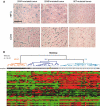SDHA is a tumor suppressor gene causing paraganglioma
- PMID: 20484225
- PMCID: PMC2901140
- DOI: 10.1093/hmg/ddq206
SDHA is a tumor suppressor gene causing paraganglioma
Abstract
Mitochondrial succinate-coenzyme Q reductase (complex II) consists of four subunits, SDHA, SDHB, SDHC and SDHD. Heterozygous germline mutations in SDHB, SDHC, SDHD and SDHAF2 [encoding for succinate dehydrogenase (SDH) complex assembly factor 2] cause hereditary paragangliomas and pheochromocytomas. Surprisingly, no genetic link between SDHA and paraganglioma/pheochromocytoma syndrome has ever been established. We identified a heterozygous germline SDHA mutation, p.Arg589Trp, in a woman suffering from catecholamine-secreting abdominal paraganglioma. The functionality of the SDHA mutant was assessed by studying SDHA, SDHB, HIF-1alpha and CD34 protein expression using immunohistochemistry and by examining the effect of the mutation in a yeast model. Microarray analyses were performed to study gene expression involved in energy metabolism and hypoxic pathways. We also investigated 202 paragangliomas or pheochromocytomas for loss of heterozygosity (LOH) at the SDHA, SDHB, SDHC and SDHD loci by BAC array comparative genomic hybridization. In vivo and in vitro functional studies demonstrated that the SDHA mutation causes a loss of SDH enzymatic activity in tumor tissue and in the yeast model. Immunohistochemistry and transcriptome analyses established that the SDHA mutation causes pseudo-hypoxia, which leads to a subsequent increase in angiogenesis, as other SDHx gene mutations. LOH was detected at the SDHA locus in the patient's tumor but was present in only 4.5% of a large series of paragangliomas and pheochromocytomas. The SDHA gene should be added to the list of genes encoding tricarboxylic acid cycle proteins that act as tumor suppressor genes and can now be considered as a new paraganglioma/pheochromocytoma susceptibility gene.
Figures





References
-
- Amar L., Bertherat J., Baudin E., Ajzenberg C., Bressac-de Paillerets B., Chabre O., Chamontin B., Delemer B., Giraud S., Murat A., et al. Genetic testing in pheochromocytoma or functional paraganglioma. J. Clin. Oncol. 2005;23:8812–8818. doi:10.1200/JCO.2005.03.1484. - DOI - PubMed
-
- Hao H.X., Khalimonchuk O., Schraders M., Dephoure N., Bayley J.P., Kunst H., Devilee P., Cremers C.W., Schiffman J.D., Bentz B.G., et al. SDH5, a gene required for flavination of succinate dehydrogenase, is mutated in paraganglioma. Science. 2009;325:1139–1142. doi:10.1126/science.1175689. - DOI - PMC - PubMed
-
- Briere J.J., Favier J., Benit P., El Ghouzzi V., Lorenzato A., Rabier D., Di Renzo M.F., Gimenez-Roqueplo A.P., Rustin P. Mitochondrial succinate is instrumental for HIF1alpha nuclear translocation in SDHA-mutant fibroblasts under normoxic conditions. Hum. Mol. Genet. 2005;14:3263–3269. doi:10.1093/hmg/ddi359. - DOI - PubMed
-
- Selak M.A., Armour S.M., MacKenzie E.D., Boulahbel H., Watson D.G., Mansfield K.D., Pan Y., Simon M.C., Thompson C.B., Gottlieb E. Succinate links TCA cycle dysfunction to oncogenesis by inhibiting HIF-alpha prolyl hydroxylase. Cancer Cell. 2005;7:77–85. doi:10.1016/j.ccr.2004.11.022. - DOI - PubMed
-
- Gottlieb E., Tomlinson I.P. Mitochondrial tumour suppressors: a genetic and biochemical update. Nat. Rev. Cancer. 2005;5:857–866. doi:10.1038/nrc1737. - DOI - PubMed
Publication types
MeSH terms
Substances
Grants and funding
LinkOut - more resources
Full Text Sources
Other Literature Sources
Medical
Molecular Biology Databases
Miscellaneous

